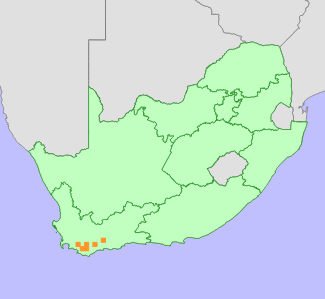|
Scientific Name | Osteospermum hispidum Harv. var. hispidum |
Higher Classification | Dicotyledons |
Family | ASTERACEAE |
National Status |
Status and Criteria | Vulnerable B1ab(i,ii,iii,iv,v) |
Assessment Date | 2012/11/14 |
Assessor(s) | L. von Staden |
Justification | EOO 366-2859 km², between four and seven locations continue to decline due to ongoing habitat loss to infrastructure development, competition from alien invasive plants and agricultural expansion. |
Distribution |
Endemism | South African endemic |
Provincial distribution | Western Cape |
Range | Caledon, Riviersonderend Mountains and Langeberg near Swellendam. |
Habitat and Ecology |
Major system | Terrestrial |
Major habitats | South Langeberg Sandstone Fynbos, South Sonderend Sandstone Fynbos, Overberg Sandstone Fynbos, Greyton Shale Fynbos, Elim Ferricrete Fynbos, Swellendam Silcrete Fynbos |
Description | Sandstone-shale ecotone on lower slopes in the Caledon area, and shaded areas in forest around Swellendam. |
Threats |
| Plants in the Caledon area are threatened by ongoing habitat loss to development as well as competition from dense, unmanaged alien invasive plants. A subpopulation known from a 1929 collection from similar habitat on the southern foot of the Riviersonderend Mountains is very likely locally extinct due to habitat loss to crop cultivation and competition from alien invasive plants. Old records with vague locality information indicate that this species may also occur further south towards the Kleinrivier and Bredasdorp Mountains, where it is also likely to be threatened by ongoing habitat loss to crop cultivation. The subpopulation on the southern slopes of the Langeberg occurs within protected areas and is not threatened. |
Population |
An extremely rare and poorly known taxon, most historical collections are from Caledon, where it was also recorded in 2006 and 2009, as locally common within small areas of remnant natural vegetation on the foot of the Caledon Swartberg. Other records are from isolated, disjunct areas further south towards Napier, where it was last recorded in 1953, and eastwards to the Langeberg, where it was last recorded in 1952.
|
Population trend | Decreasing |
Notes |
| Norlindh (1943) included one specimen from Grootvadersbos forest on the southern slopes of the Langeberg with O. hispidum var. hispidum, but remarked that this collection is not especially characteristic of the taxon. One other collection from indigenous forests in the adjacent Marloth Nature Reserve is known, but these remain disjunct from the Caledon collections, and together with major habitat differences, point to a possible unrecognized separate taxon. Should O. hispidum var. hispidum be confirmed to be restricted to the Caledon area, it will meet the criteria for the category Endangered. |
Assessment History |
Taxon assessed |
Status and Criteria |
Citation/Red List version | | Osteospermum hispidum Harv. var. hispidum | Threatened | 2012.1 | | Osteospermum hispidum Harv. var. hispidum | Threatened | Raimondo et al. (2009) | |
Bibliography |
Harvey, W.H. 1894. Compositae. In: W.H. Harvey and O.W. Sonder (eds). Flora Capensis III (Rubiaceae to Campanulaceae):44-530. L. Reeve & Co., Ltd., Ashford.
Norlindh, T. 1943. Studies in the Calenduleae. 1: Monograph of the genera Dimorphotheca, Castalis, Osteospermum, Gibbaria and Chrysanthemoides. Gleerup, Lund.
Raimondo, D., von Staden, L., Foden, W., Victor, J.E., Helme, N.A., Turner, R.C., Kamundi, D.A. and Manyama, P.A. 2009. Red List of South African Plants. Strelitzia 25. South African National Biodiversity Institute, Pretoria.
|
Citation |
| von Staden, L. 2012. Osteospermum hispidum Harv. var. hispidum. National Assessment: Red List of South African Plants version 2024.1. Accessed on 2025/12/23 |
 Comment on this assessment
Comment on this assessment


